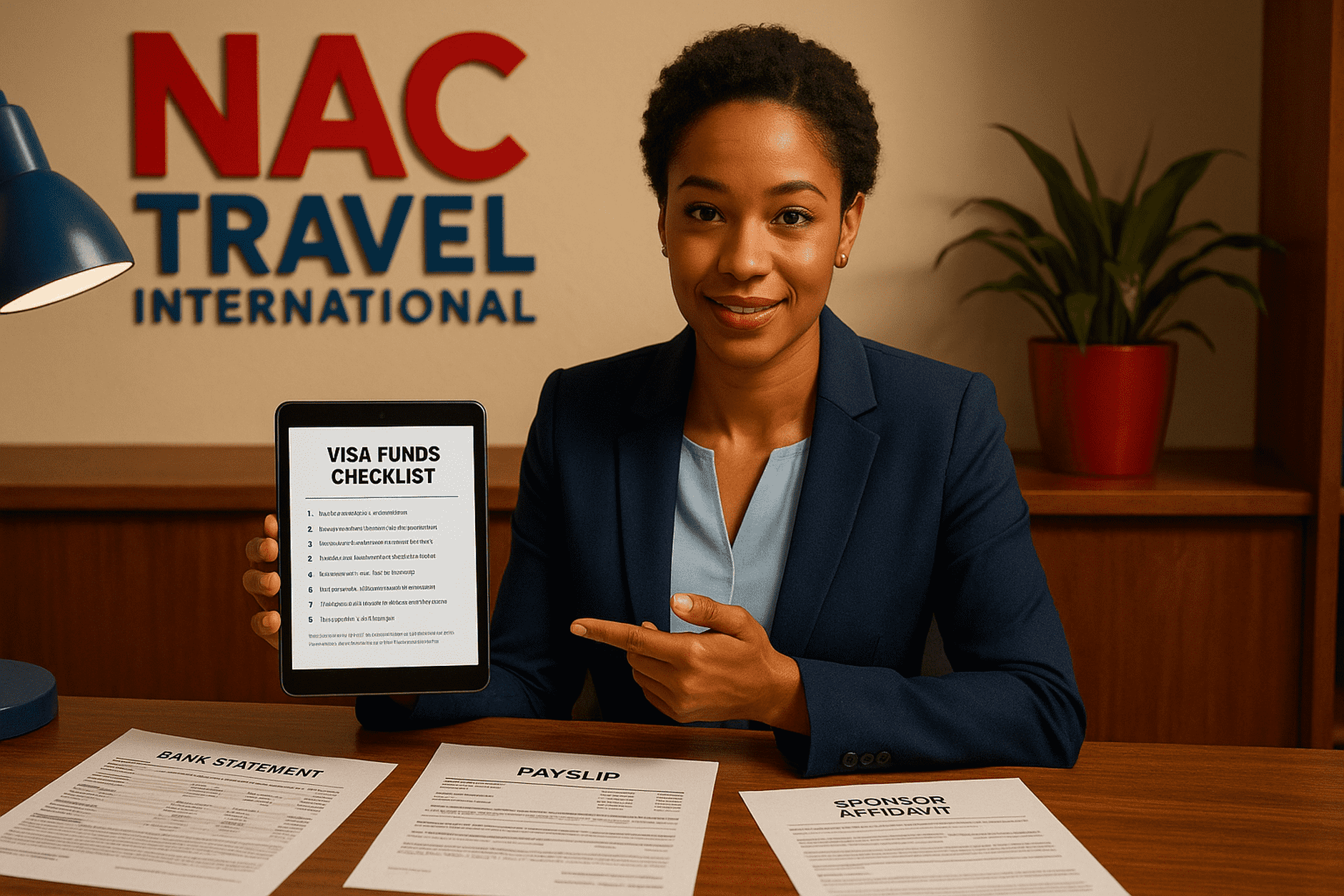Visa officers want to see that your trip is affordable and that the money is truly yours to use. You do not need to lock cash away for ages. What you need is a clean, consistent money trail that matches your itinerary and shows the funds are accessible. Here is a practical plan that keeps your cash flexible and your application strong, plus how NAC Travel International can set it up with zero guesswork.
What consulates really look for
-
Sufficiency: enough money for flights, accommodation, daily expenses, insurance, and a buffer.
-
Source and stability: regular income or savings that make sense for your profile.
-
Accessibility: funds you can actually use during the trip.
-
Consistency: dates, balances, and bookings that tell one story.
You do not have to be rich. You do have to be credible.
Build a money trail without freezing cash
1) Use a primary spending account plus a savings buffer
Keep your travel funds in your normal current account and hold extra in a linked savings account. Provide statements for both. This shows access and avoids last-minute lump sums that look borrowed.
2) Prove income with patterns, not snapshots
Include three to six months of bank statements and payslips or business income records. Officers prefer steady inflows over a single big deposit.
3) Explain any large or unusual deposit
Write a short explanation and attach proof. Examples: bonus letter, asset sale receipt, matured fixed deposit, tuition refund, grant award. Silence invites doubt.
4) Count what you have already prepaid
Hotel deposits, tour payments, internal flights, and travel insurance reduce required cash. Include paid invoices and booking confirmations.
5) Add secondary assets that are easy to access
Bank letters for term deposits with early-withdrawal options, money market statements, or verified investment accounts help. Avoid crypto proofs and cash slips, which most consulates do not accept.
6) Keep sponsor help transparent and limited to gaps
If a parent, spouse, or employer will fund part of the trip, include a simple sponsor pack:
-
Sponsor letter or affidavit of support
-
Relationship proof
-
Sponsor statements and payslips for the same period as yours
-
Clear note of what the sponsor will cover
Use sponsorship to top up your position, not to replace your own evidence entirely.
7) Match balances to a costed itinerary
Show a realistic budget: nights, transport, daily meals, activities, and a contingency. Align totals with your bank balances. If your plan is affordable on paper, your balances should reflect it.
8) Keep money moving naturally
Avoid shuffling funds across accounts just before your appointment. Sudden transfers trigger questions about loans or temporary parking.
9) Use the right account names
Submit statements in your name or a joint account that lists you. Business accounts require proof of ownership and a note that funds are available for personal travel.
10) Time your paperwork
Collect statements that end close to your appointment date. If your bank cycles mid-month, ask for a stamped interim statement so balances are current.
Simple timeline you can copy
Eight to ten weeks out
-
Map total trip cost and set a target balance that covers it with a buffer.
-
Move only what is necessary into your main account and stop unnecessary transfers.
Four to six weeks out
-
Prepay key items you would buy anyway: insurance, internal transport, tour deposits.
-
Collect employer letters or business docs that confirm income.
Two to three weeks out
-
Print or download official bank statements, not screenshots.
-
Draft short notes that explain any unusual activity.
One week out
-
Get a stamped interim statement if needed.
-
Assemble the sponsor pack if someone is helping.
Common pitfalls that cause refusals
-
Cash deposits with no paper trail.
-
Borrowed money that appears just before the appointment.
-
Statements that do not match the itinerary dates or names.
-
Overreliance on a sponsor without proof of relationship and income.
-
Screenshots instead of official statements or bank letters.
How NAC Travel International makes this easy
Visa-ready money trail
We calculate a destination-specific budget, then design the exact mix of statements, payslips, and bank letters that proves access without locking your cash. You get a tidy pack labeled and cross-referenced to your itinerary.
Sponsor affidavits that pass checks
We prepare a clean sponsor letter or affidavit, list required attachments, and ensure names, dates, and amounts align with your file. If employer funding is involved, we draft compliant support letters and travel policies.
Timing and templates
You get a week-by-week checklist for statements, interim updates, and explanation notes. We supply templates for large-deposit explanations and asset-sale receipts.
Gap strategies
If the budget is tight, we suggest documented cost reducers: prepaid accommodation, longer stays in lower-cost regions, student or corporate discounts, and verified payment plans where accepted.
Quality control
Before you submit, we reconcile numbers against bookings so the officer sees a coherent story from page one.
Bottom line
You do not need to freeze money for months to get a visa. You need a believable budget, steady statements, clear explanations, and documents that prove access. NAC Travel International builds that structure for you so your funds stay fluid, your file is strong, and your trip gets a fair and fast review.
